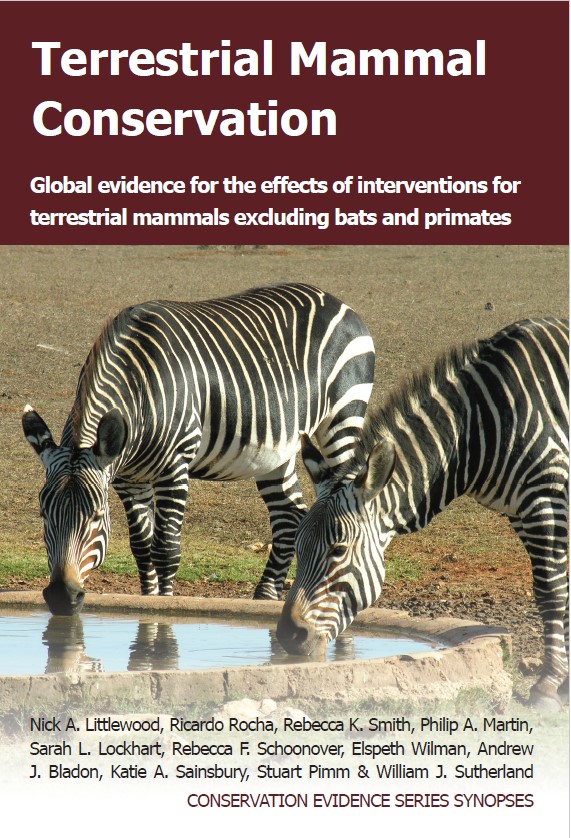Thin trees to reduce wildfire risk
-
Overall effectiveness category Likely to be beneficial
-
Number of studies: 3
View assessment score
Hide assessment score
How is the evidence assessed?
-
Effectiveness
50% -
Certainty
50% -
Harms
0%
Study locations
Supporting evidence from individual studies
A replicated, controlled, before-and-after study in 1998–2003 of ponderosa pine Pinus ponderosa forest in Arizona, USA (Converse et al. 2006) found that reducing tree density increased abundances of two of four small mammal species. Deer mouse Peromyscus maniculatus and gray-collared chipmunk Tamias cinereicollis captures were both positively associated with decreasing tree density in treatment plots but golden-mantled ground squirrel Spermophilus lateralis and Mexican woodrat Neotoma exicana captures showed no such relationship. Results were presented as statistical model outputs. Three blocks, each with four 14-ha plots, were studied. Treatments comprised removal of all trees except those dating from pre-European settlement and, within 18 m of those trees, retention of 1.5, 2 or 3 trees with dbh ≥41 cm (or twice this many trees with smaller dbh, if larger trees not available). Thinning was conducted in 1999. Most woody debris was then piled up and burned, followed by prescribed burning of the whole plot in April–July 2000. The fourth plot in each block was unmanaged. Small mammals were live-trapped in August–October in 1998–1999 and 2001–2003.
Study and other actions testedA replicated, controlled study in 2005–2006 in a coniferous forest in Oregon, USA (Long et al. 2009) found that thinning followed by prescribed burning did not increase use of areas by North American elk Cervus canadensis, in most season, stand age and sex comparisons. Thinning and burning were carried out on the same plots, so their influences could not be separated. In spring, female elk used plots burned two and three years previously, proportionally to their availability, preferentially selected 4-year-old burns, and avoided 5-year-old burns. They showed no preference for thinned and burned plots in summer. Male elk did not show preference for any thinned and burned plots, relative to their availability, in spring or summer. Stands not thinned and burned were avoided by females and selected by males in spring. In summer they were selected by females and males showed no preference. Data all presented as selection ratios. In 2001–2004, twenty-six forest stands (average 26 ha) were thinned between May and October, followed by prescribed burning during September or October of either the same or the following year. Twenty-seven similar stands (average size 55 ha) were not thinned or burned. Eighteen female and five male elk were radio-collared in spring 2005 with 30 female and nine male elk radio-collared in spring 2006. Locations were recorded automatically, within 1 hour of sunset or sunrise.
Study and other actions testedA systematic review in 2008 of management aimed at restoring natural processes in conifer forests in southwestern USA (Kalies et al. 2010) found that, in forests thinned by removing small- to medium-diameter trees, two mammal species were recorded in higher densities compared to in unmanaged forests, while three species showed no effect. Higher densities associated with thinning were seen in gray-collared chipmunk Tamias cinereicollis and Mexican woodrat Neotoma mexicana. No significant responses to thinning were detected for tassel-eared squirrel Sciurus aberti, deer mouse Peromyscus maniculatus or golden-mantled ground squirrel Spermophilus lateralis. The review used evidence from 22 studies and considered responses of species recorded in ≥5 studies. Densities of species in ponderosa pine Pinus ponderosa forests managed in five ways, to recreate natural conditions and forest dynamics and reduce wildfire risk, were compared with densities in unmanaged forest.
Study and other actions tested
Where has this evidence come from?
List of journals searched by synopsis
All the journals searched for all synopses
This Action forms part of the Action Synopsis:
Terrestrial Mammal Conservation
Terrestrial Mammal Conservation - Published 2020
Terrestrial Mammal Conservation





)_2023.JPG)














